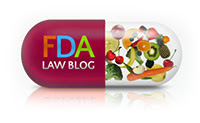
Posted: 03 Feb 2019 09:00 PM PST In yet another step to address drug pricing, Commissioner Gottlieb announced last week several new initiatives, including an update to the reveredOrange Book. Cue the crazy Muppet arms! Proclaiming the Orange Book update a “transparency initiative,” FDA expects that this undertaking will “provide greater certainty around timing of market entry and enable more informed decisions.” This is all part of the Agency’s extensive effort to enhance competition, which has resulted in several new guidance documents pertaining to generic development, efforts to reform the Citizen Petition process, new priority reviews, an ICH proposal, and other efforts to expedite generic approval. As Commissioner Gottlieb points out, FDA has made great strides in streamlining the generic review process in the last few years, including record numbers of generic drug approvals and tentative approvals in 2017 and 2018. Over the course of 2019, FDA intends to issue two Orange Book-focused draft guidances. The first is a draft guidance document explaining the process for therapeutic equivalence evaluation and the assignment of the TE codes listed in the Orange Book. This is intended to facilitate requests for TE codes, as well as encourage development of more therapeutically equivalent drugs – particularly under the 505(b)(2) pathway, as 505(b)(2) applicants typically must request a TE code by Citizen Petition (unlike ANDAs, where a TE code is routinely assigned upon listing). As such, FDA also believes that such clarity on TE codes may facilitate development of complex generics through the 505(b)(2) pathway. The second Orange Book guidance will be a draft guidance with FAQs about reading and using the Orange Book. FDA also plans to solicit public comment on the use of the Orange Book with an emphasis on potential enhancements. It also seems like FDA may finally address whether drug-device patents – or now, given the hi-tech era we are in – drug-digital app patents should be listed in the Orange Book. Industry has been asking for instruction on this issue for about 15 years, and without word from FDA, many manufacturers have decided to list them anyway if the device is integral to the drug as approved, so it will be interesting to see if FDA will change the current practice. Again, FDA is doing this for the purposes of transparency so that potential manufacturers can now determine if a digital app patent might block marketing of a generic drug before investing resources. FDA also announced a new guidance document, Marketing Status Notifications Under Section 506I of the Federal Food, Drug, and Cosmetic Act; Content and Format, which provides notification instructions for discontinued drugs, as required under FDARA. 506I of the FDCA requires manufacturers to provide notification to the Agency of the drug withdrawn from sale or the unavailability of a drug and requires the submission of a one-time report on marketing status for actively marketed drugs. These statutorily-required notifications are intended to help the Agency understand which products are actively marketed and where there is a need for more generic competition. Of note, the guidance explains that “withdrawn from sale” does not mean that the NDA or ANDA itself has been withdrawn, but that the drug has been discontinued from marketing – even temporarily. FDA will use these notifications to determine whether to move products not available for sale to the “Discontinued” list. Applicants withdrawing their product from sale must submit the notification 180 days prior to withdrawal, and newly approved drugs must submit the notification within 180 days of the date of approval of a drug if that drug will not be available for sale within 180 days of the date of approval. Notifications are expected to include NDC numbers (for previously marketed drugs); the established name of the drug; the proprietary name of the drug, if applicable; the NDA or ANDA number; the strength of the drug; the date in which the drug will no longer be for sale or on which the drug will be available for sale, if known; and the reason for withdrawing or not marketing the drug. Application holders who fail to submit this notification may also find their drugs moved from the “Active” to the “Discontinued” list. Needless to say, we here at the FDA Law Blog are excited. |





















.png)









No hay comentarios:
Publicar un comentario